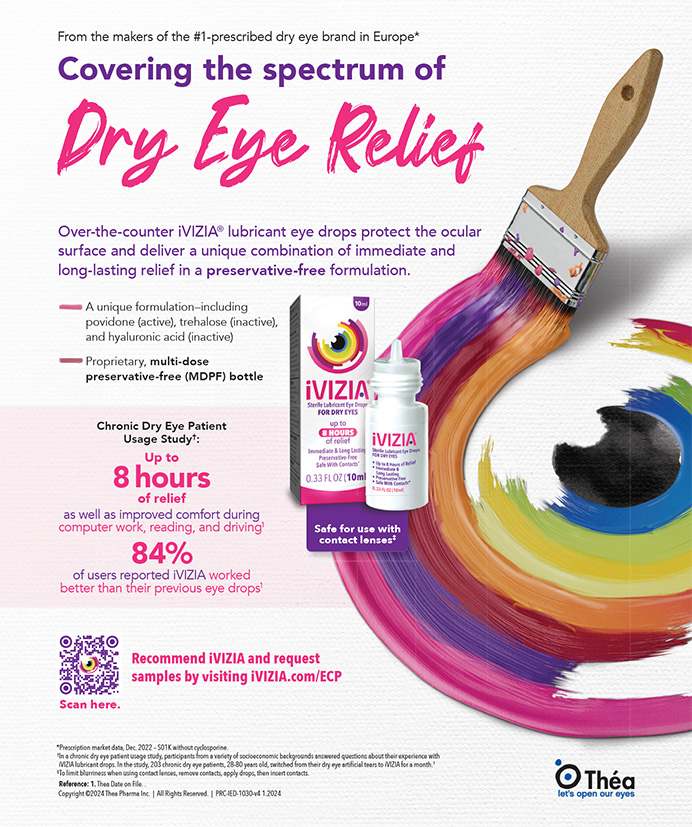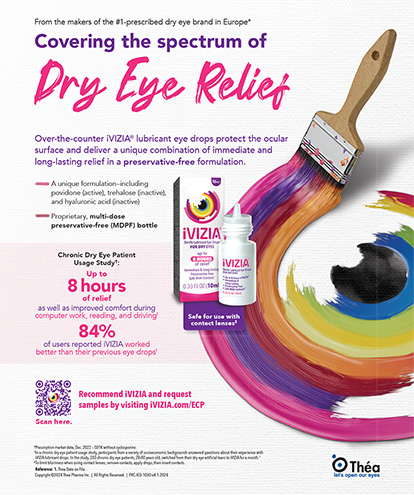Recent studies1,2 on the location of aberrations in the normal eye have suggested that the young crystalline lens partially compensates for positive corneal aberrations by virtue of its negative spherical aberration but that this effect is lost with age.3 In contrast, the cornea changes little with age. The manufacturers of ophthalmic lenses have therefore developed aspheric designs to correct for the spherical aberration of the cornea.4,5 Laboratory studies using adaptive optics6 and clinical studies have demonstrated the visual benefit of these IOLs.7
Correcting the corneal spherical aberration improves the contrast of the retinal image. A question is whether that strategy also reduces depth of focus and therefore renders the pseudophakic eye more vulnerable to errors in defocus. Another important issue is the impact of a misaligned IOL on optical and visual performance. In some cases, the benefit of correcting spherical aberration could be reduced or even negated by the introduction of off-axis aberrations due to the lens' misalignment.
We developed ray-tracing modeling using actual data and have found it to be an extremely useful tool for predicting the optical performance of different types of IOLs after cataract surgery.8 As this article describes, our results were not what one might expect.
VIRTUAL CATARACT SURGERY
We combined data on the measured corneal topography; the IOL's tilt, decentration, and geometry; and the eye's geometry to predict?through computational ray tracing?the optical performance of eyes implanted with two different types of IOLs. We called this procedure virtual cataract surgery. We estimated the wavefront aberration of the cornea from corneal elevations at a sample of points obtained with a Placido-based corneal topographer (Atlas; Carl Zeiss Meditec, Inc., Dublin, CA). To estimate the IOL's tilt and decentration, we developed an instrument based on recording the Purkinje images of a semicircular ring of infrared LEDs for several, well-defined fixations. For each patient, we obtained measurements of axial length and the IOL's axial position.
All of these data were incorporated into the computer ray-tracing model, developed using optical software (Zemax Development Corp., San Diego, CA). The corneal surface was decentered relative to the pupillary center by those values obtained from the corneal topographer. We measured the degree of the IOL's tilt and decentration for each subject postoperatively with our Purkinje-meter system and then incorporated the information into our calculations together with the IOL's axial position, the ocular axial length, and the geometrical details. The specifics of the IOLs' geometry and refractive indices were provided by their manufacturer, Advanced Medical Optics, Inc. (Santa Ana, CA), and we incorporated the information into the model. We compared the company's Tecnis TM Z9000 and Ceeon 911A lenses. Both are foldable, silicone IOLs with a high refractive index (1.458) and a 6-mm optical zone. The Ceeon model is a biconvex lens with spherical surfaces, whereas the Tecnis is an aspheric IOL designed to correct for the average value of corneal spherical aberration.
We incorporated experimental data from a series of cataract patients into the computer model to predict the virtual postoperative ocular aberrations for a variety of conditions and the two types of lenses. Figure 1 provides a schematic view of the complete customized procedure with real aberrations for one patient. We measured the ocular wavefront aberration using our own research-based, prototypic, nearly infrared, Hartmann-Shack wavefront sensor adapted to the clinical environment. This system consists of a microlens array, conjugate with the eye's pupil, and a camera placed at its focal plane. The comparison of the predicted and measured aberrations in several real patients validated our modeling approach.
DEPTH OF FOCUS WITH ASPHERIC AND SPHERICAL IOLs
We studied the depth of focus (pseudoaccommodation) provided to real eyes by both the conventional Ceeon lens and the aspheric Tecnis. We predicted the retinal image quality in 24 patients with the lenses for different values of defocus. As an optical quality metric, we calculated the modulation transfer function at six cycles per degree. Figure 2 shows the average value for all patients as a function of defocus for both IOLs. At best focus, visual performance was better with the aspheric lens, as one would expect. For different values of defocus, however, the Tecnis lens performed better or similarly to the spherical lens. This finding indicates that the aspheric Tecnis IOL generally improves retinal contrast at best focus and also for small values of defocus. In other words, actual pseudoaccommodation is not compromised.
Our results may seem counterintuitive. In a simple, rotationally symmetric eye model for which defocus and spherical aberration are the only variables, removing spherical aberration does indeed reduce the depth of focus. Figure 3 shows that type of calculation with our modeling when only symmetrical terms were considered. In such an unrealistic case, the Tecnis IOL would perform best at best focus, but the Ceeon lens would be superior for certain degrees of defocus. The eyes of real cataract patients are not affected by spherical aberration alone, however. In the presence of the other higher-order aberrations, correcting spherical aberration improves visual quality at best focus and also for a small refractive error that may occur intraoperatively (Figure 2). Aspheric IOLs therefore do not compromise patients' depth of focus.
Pablo Artal, PhD, is Professor at the Laboratorio de Óptica, Universidad de Murcia, Spain. He has received support for his research from Advanced Medical Optics, Inc. Dr. Artal may be reached at 34 968357224; pablo@um.es.
Juan Tabernero, MSc, is a doctoral candidate at the Laboratorio de Óptica, Universidad de Murcia, Spain. He acknowledged no financial interest in the products or company mentioned herein. Mr. Tabernero may be reached at juant@um.es.


